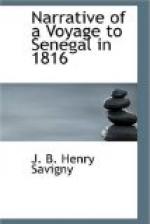If our course during the night had partly averted all our dangers, that which was taken in the morning led us into them again. Mr. Maudet, convinced that we were upon the reef, took upon him, to have soundings taken; the colour of the water was intirely changed, which was observed even by those who were the least used to recognise the depth of the sea, by the appearance of the water; we even thought that we saw sand roll amid the little waves that rose; numerous sea weeds were seen by the ship’s side, and a great many fish were caught. All these facts proved indubitably that we were on shallow water: in fact the lead announced only eighteen fathoms; the officer of the watch immediately informed the captain, who gave orders to come a little more to the wind; we were going before the wind the studding sails on the larboard; these sails were immediately lowered; the lead was again cast, and showed six fathoms; the captain gave orders to haul the wind as close as possible, but unhappily it was too late.[A7][B1]
The frigate luffing, almost immediately gave a heel; it proceeded a moment longer; gave a second and then a third; it stopped at a place where the sounding line showed only a depth of five metres sixty centimetres, and it was the time of high water.
Unhappily we were in the season of the high tides, which was the most unfavorable time for us because they were going to decline, and we ran a ground just when the water was at the highest; for the rest, the tides do not much differ in these seas; at the time of full moon they do not rise more than fifty centimetres more than usual; in the spring tides the water does not rise above one hundred and twenty centimetres on the reef. We have already said that when we grounded, the sounding line marked only five metres, and sixty centimetres; and at low water it marked, four metres sixty centimetres, the frigate therefore saved by a metre: however, as soon as we had stranded, the boats which went out to sound, met with places deeper than that, where we struck, and many others not so deep; which made us suppose that the reef is very uneven and covered with little elevations. All the different manoeuvres which had been performed since the moment when we found ourselves in eighteen fathoms, to that in which we struck, succeeded each other with extraordinary rapidity: not above ten minutes passed. Several persons have assured us that, if the ship had come entirely to the wind, when we were in eighteen fathoms, the frigate might perhaps have got clean, for she did not run wholly aground till she got to the west part of the reef, and upon its edge.




